Text
Making Connection
Thinking about communication and electric poles led me to research how the telephone network works, both in the UK and around the world, especially the states since it appears that most inventions took place there.
0 notes
Text
Infrastructure Installation
I discovered that Akira Yamaguchi had even put together an installation, juxtaposing the complexity and mysticism of the electric poles and the cleanness of the interior of the gallery enclosing them, which makes them feel out of place, further bringing the viewer's attention to them.
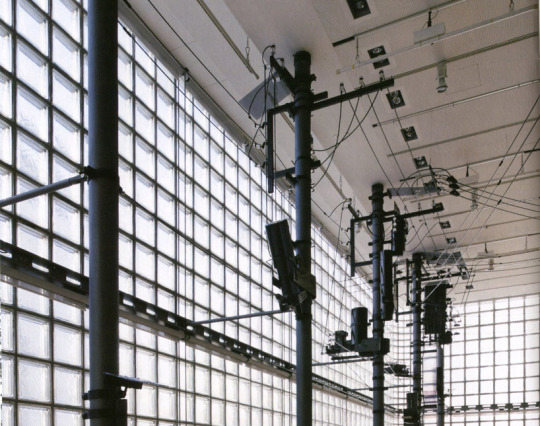
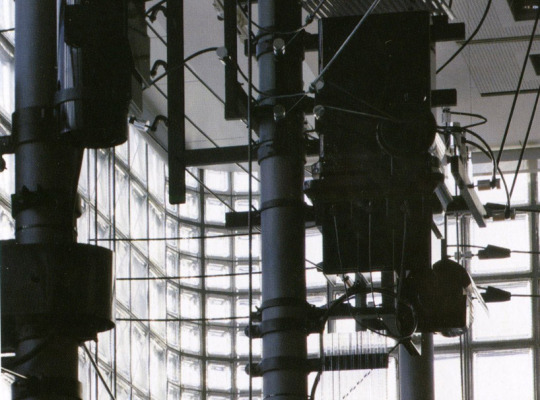
Images found on Design Boom.
4 notes
·
View notes
Text
Writings: In the Booth
***
The even drumming of the raindrops against the metal roof of the shelter is soothing. The jurassic-green ferns that have grown around the telephone booth also give in under the heavy and frequent drops, which make a patting sound as they fall on the leaves. Even in these showers, the black wires never cease to be alive. They almost seem to wrap around the electric pole, without any attempt to make themselves hidden, but instead are all exposed and interweaved with one another, like an organism. The pole is wooden, one of the little wooden ones remaining - because of its antique nature, it makes this telephone booth more special than the others. Many cracks and splits mark the surface of the pole; holes can be traced among the streaks of moss, where objects have been mounted and dismounted as the functions of the telephone network have changed over time. The pole stands firm, although slightly bent to one side, and shows its pride in having withstood time and continual use.
A drop of rain falls from the insulator at the top of the pole and trickles down the side of the rusting grey cylindrical transformer, down along another cable, and onto the pivot disk that lowers it into the service tube of the booth, from where the cable feeds into the telephone device. The insulation has started to peel, so the raindrop enters the enclosure and makes its way down through the layers of the roof and onto the underside of the interior ceiling. It lingers there for some moments, before cascading and landing on Avery’s cheek.
She is taking her time in the booth. Even after the familiar disciplined and decorous voice of the telephone operator comes out with a slightly metallic resonating “Code please,” she is still silent. Should she make the call? Or just leave it, and go back?
Outside the drizzling has turned into a shower. The drops are clanging harder against the metal alloy, the surrounding brick houses become enshrouded in a misty blue curtain of rain that drapes to the ground and gathers in piles. A car drives by, its tires cut through a deep pool of water and wash the booth door.
2 notes
·
View notes
Text
Mas Yendo's World Pt. 2
[I recommend listening to this while reading]
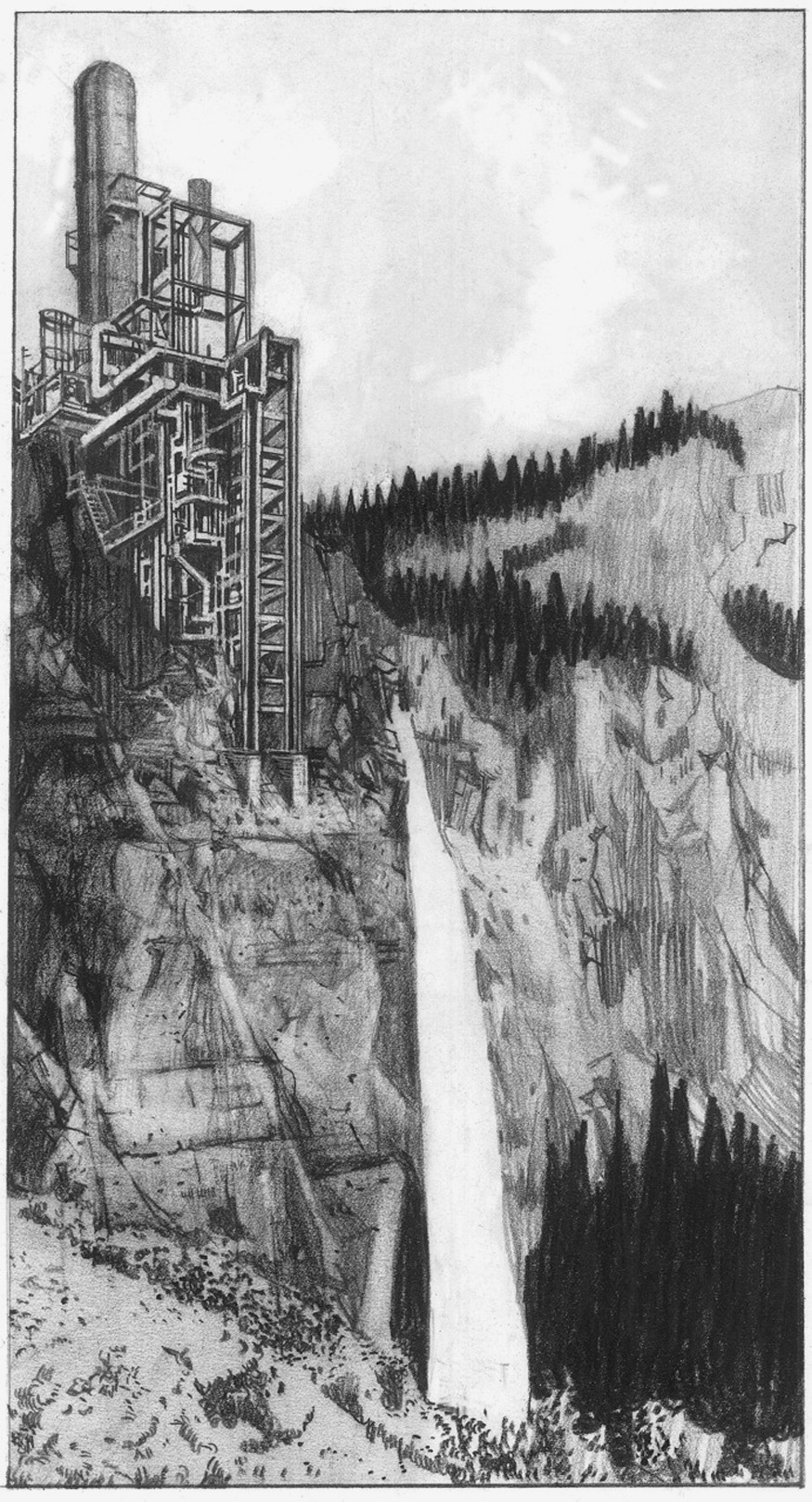
I also discovered Mas Yendo's skilfully hand-rendered landscapes which tie in so well with his post-catastrophe-like rugged machines for inhabitation. Here are the writings of Lebbeus Woods taken from his blog. Lebbeus Woods was Yendo's teacher at a private institute.
There are several levels on which we can approach this small series of drawings by Masahiko Yendo. Made at the same time as his celebrated projects published in Ironic Diversion, these virtuoso pencil drawings are lyrical visions of a harmonious meeting of human and natural worlds. In them the natural landscapes seem as constructed as the buildings seem to have grown and evolved through geo-tectonic processes. While they remain distinctly different from one another, the buildings and landscapes interact creatively, somehow dependent on each other. The drawings’ lyricism—their exaltation of form and texture and meaning—differentiates them from actual situations where industrial architecture pollutes virgin landscapes. Something in the drawings convinces us that they belong together, even though our experience insists that they do not. Here we touch on Yendo’s sense of the ‘ironic’ or, perhaps the paradoxical nature of reality, which emerges from contradictions that can only be resolved through art and the heightened sensibilities it inspires.


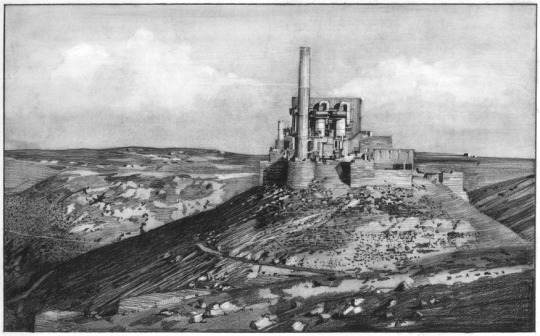
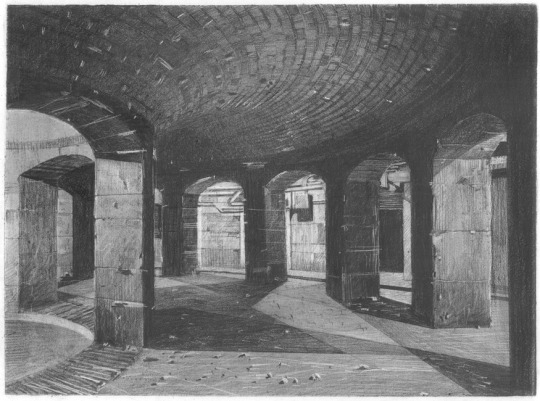

I can't begin to explain the impact these renderings had on me. Especially because his world is like an amplified version of the story I had in my mind which I had just started typing up on my computer.
They exude an atmosphere strikingly similar to what I have been trying to convey. Now I am on a quest how to do that more effectively.
Images courtesy of Lebbeus Woods' blogpost.
9 notes
·
View notes
Text
Entering Mas Yendo's world
[I recommend listening to this while reading]
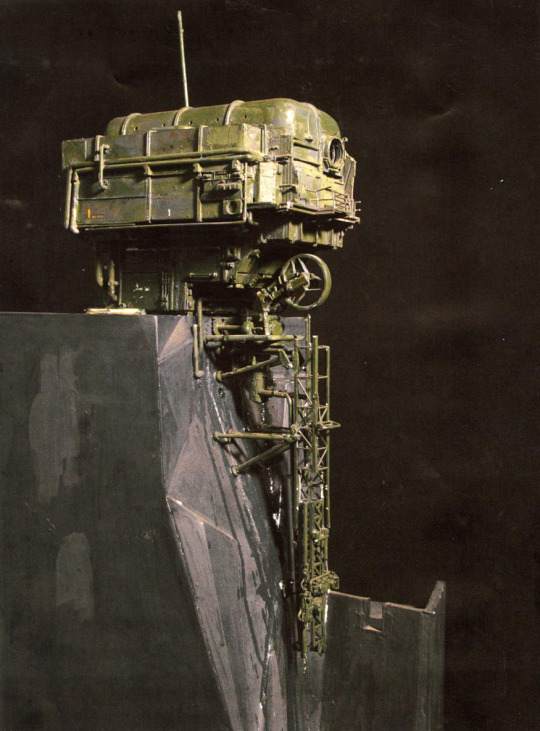
Masahiko Yendo created these Machines for Living in The End of Times - uncanny structures that make me so fascinated and slightly uneasy. Without being able to fully explain why, I was so inspired by his material palette, attention to detail, and mysterious purposefulness. This precedent was also suggested to me by my tutor.
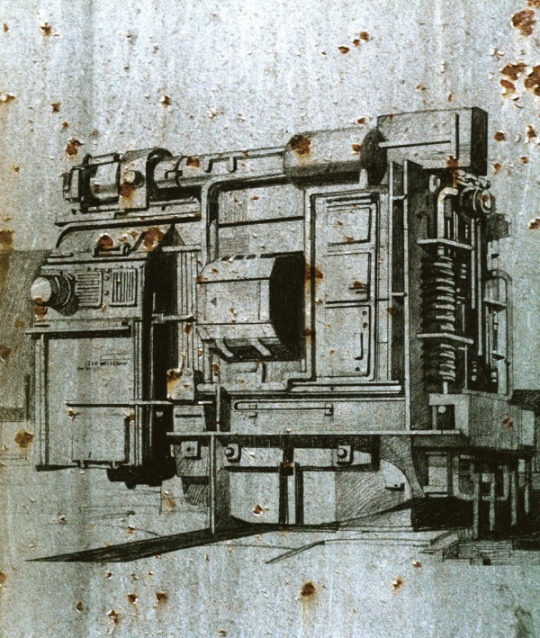
Socks Studio write:
Masahiko (Mas) Yendo’s work draws heavily from the perverse fascination with worn out machinery: industrial hardware, in Yendo’s world can be reused, reconfigured, converted into machines for individual inhabitation. Science fiction, space travel, and apocalyptic dystopia provide an inspiring imaginary for the japanese architect and theorist.
Much of Yendo’s vision is gritty and dark. It is that of the ecological disaster, of an hostile modern life, of alienation and consumerism.
[His] living units harbor a sense of community, a hope for civilization longed for in a post-apocalyptic agenda.
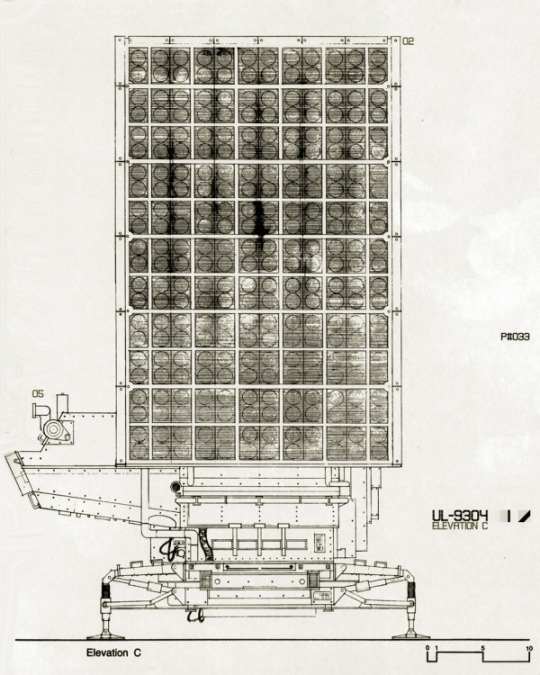

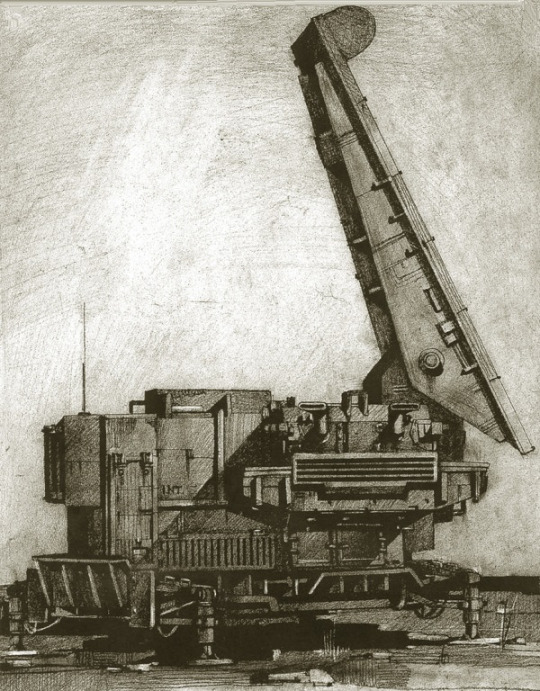
images from Socks Studio
2 notes
·
View notes
Text
Writings: Retrospective
Part I: Walking through Mercery Lane
***
When I first moved into CbDx2, known historically as Canterbury, I was mesmerised by the ear-tingling buzz ever so present around the streets close to the main telephone central. Of course, one might argue that it’s something that we imagine rather than sense, but either way this is something that I like to indulge in on my way to work in the morning.
Today the weather is particularly wet and foggy, which drowns out the resonation of my boots tapping onto the heavy cobblestones. This area of England is known for the moody weather conditions, similar to the coast of the Continent. Sometimes the fog here doesn’t lift for days, but for me it only reinforces the charm of the town. It wraps around it like a blanket, penetrates through every lane and street, shrouds the houses. Only the black rigid wires overhead cut through it, their uninterrupted continuum circulating through the town, sometimes traveling in bunches, and sometimes a single fragile line connecting one building to another. They all portray a sense of direction and purpose, as if they are traveling on a very important mission. They do connect the whole town, so to a certain degree they do have a very important mission. They jump from one roof here onto a facade of a building across the street there, and onto another facade, eventually connecting into a telephone pole where they get distributed to another street. They almost have a life of their own. They almost co-inhabit the town with us.
I try to watch where I step so that I don’t stumble in the deep grooves that have formed between the old stones, like an orderly spiderweb. Looking down, I can only begin to fathom how many feet have trod on these exact same stones here on Mercery Lane over the generations. Some stones are particularly worn smooth, such as the ones forming the corner of the kerb. Each piece has a variety of colours forming the overall earthy brown appearance: notions of deep blue and green, like the patina that forms on copper. In the precipitated weather, they all glisten as you move through the street. Because of that, they say that someone is responsible for polishing them in the small hours of the night, ready for the soles of dozy workers who will be striding down busily and purposefully not long after, on their way to work, just like me. Today however, hadn’t spotted any people for the whole duration of my walk, perhaps because of the densening fog. For a second, I get the feeling that I am the only citizen in CbDx2 but I quickly shrug it off when I spot old Sam grunting and lifting the security grill over his gallery on Buttermarket square as I come out of Mercery Lane.
And right there, the telephone central emerges from the fuzzy white veil. Many lines of cables join into groups, coming together from the nearby streets, collating into a jet black river-like mass flowing above and onto the supports protruding from the war memorial which is the final step of the distribution of the wires. Here they are all redirected into the Telephone Central, where their rubbery nature is decoded into sound waves carrying a someone’s voice ready to be connected to someone else. Seconds after going into the building’s facade, the mass of wire finds its way through pipes and conductors, one by one being separated and broken up as they traverse in between and through networks, to eventually reach a wooden deck in the form of a plug-ended cord, ready to be unhooked, stretched and jacked into another indexed hole, thus instantly making a connection between two voices, under the swift manoeuvres of a switchboard operator’s hands.
The telephone central itself appears as quite a small building from the outside, considering the importance of its duty to connect the whole town. Sometimes I wonder whether the only reason for the strict limit of residents allowed to move in is only because of the capacity of the telephone central. Surprisingly though, there are so many operators employed there. My shop is further down Burgate lane, where uniformed telephonists scurry past my shop windows. I’m not lucky enough to see my wife on her way to the central though, as her shifts tend to start at 5am on most days. Her duty is supervising a section of switchboards, so she needs to arrive before her subordinates and be ready to take charge of the systems as the night shifters prepare to get back home.
* * *
I usually finish up and close down the shop around 5:30pm, when the sun is just about to set. As soon as the streetlights flicker a few times and lighting the square, the Buttermarket’s vail of silky fog is washed over with a warm ember glow. Through my shop window, the view looks like an old sepia-toned snapshot that has come alive from decades ago. In fact, the whole town has an a very 50s noir atmosphere, which I’d grown to love because it reminds me of many sweet childhood memories, watching gran’s favourite films with her in the early noughties, especially films from the 50s - her adolescence. She would have loved a quaint small house on the outskirts of town here. The virus took away many things.
* * *
Today Esme dropped by my shop during her lunch break to see me and let me know she’ll have a late shift today - her colleague Charlotte Burton had sent a personal note to Esme, telling her she’s fallen ill with some flu. I still sometimes scold Esme for disclosing such information, even to me. I feel sorry for Charlotte and the odd looks she’ll get from people for quite a while after she’s recovered.
0 notes
Text
In Writing
These controversies started to mould into an idea. I started typing the short story that had to be formed by an article and my views on the future of hospitality (as mentioned in the previous post). As I was writing, it started to turn into a the story of a man who is walking through Mercery Lane, one of the oldest streets of Canterbury, in the town centre, which is even a protected heritage area together with the buildings in its vicinity.
[ I recommend listening to this while reading ]

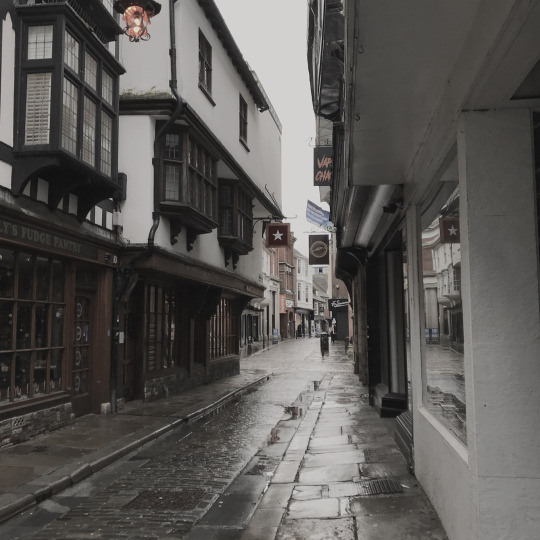
The writing takes form of a stream of consciousness as he is describing his surroundings on his way to work in a misty early morning.
As I was writing, it felt like the story was drifting into the future. So as a response to the topic of the future of hospitality, I set my story in 2032 in Canterbury, which is now CbDx2 - a town in a chain of establishments that have abandoned all radio-wave emitting devices and reverted back to analogue technology.
In my story, this has started in 2022. I used the controversies from 2020 but my timeline drifted from reality towards the middle of 2021, when, in my version on history, people would become increasingly more paranoid with the 5G technology, and that somewhat irrational fear would grow into fear of any device or piece of tech that works with wireless technology, whether it'd be charging or transferring data, or even heating up food, like microwave ovens. So, in 2022, people would form a national, and maybe even global, movement to abandon any wireless technology.
In the UK, they would put increasing pressure on the government to do something. Of course, no country would be willing to abandon their profit and business coming from development and implementation of new technologies. The government's response would then be to create a network of several cities across the UK that are of historical significance, and turn them into analogue-technology-only towns. Canterbury would be one of them.
Anyone who fears the new technologies could sign up and apply for a residency in any of those towns; it should be kept in mind that places are limited, through, as they are heritage sites and are not given to expansion or redevelopment.
People can work and live in peace, sheltered from any invisible signals and spread of the virus, which go hand in hand, as they believe.
Because of no signals however, there has been in fact an impact on living beings - specifically on the flora; Nature has started to regain its territory from outside the city walls to the inside, with peculiar and robust growth of trees, shrubs and other forms of plants that thrive in moist conditions. Quickly moss and ivy have begun overtaking many structures and softening the landscape, mixing with wires, metals, woods... growing into an unanimous existence with man-made interventions.
0 notes
Text
Controversies Leading to Narratives
The more I read and research electric poles, the more I grow an inexplicable fearful fascination with them.
Now I am thinking about how to use them to reconnect people in these times of disconnection.
Finding myself at a block, I tried my hand at writing a short piece since that was also a quick exercise allocated in one of the project briefs. It asked to connect some article with my own views of the future of hospitality. I stumbled across some articles from 2020 with controversial beliefs about 5G, such as that the radio waves speed up the spread of the virus or even generate it, and some even believing that the virus was released and a lockdown put in place, only so that the masses can stay at home while the government installs 5G towers across the UK. In America, some were of such strong conviction that 5G signal and 5G towers are a great woe that there have been protests against them and some have even been forcefully set on fire or brought down by the crowds. Some 'evidences' that these claims use are, for example, and image of a worker in a white hazmat suit usually assimilated with extreme biohazards environments, cleaning a 5G tower masked as a palm tree using a pressure washer.
All such beliefs and opinions have been disproved and have been uncovered as falsely grounded with little to no evidence, while there is plenty of research that assures mass consumers of the safety of 5G as well as any other microwave signals that we are exposed to on the daily. Most importantly they show no links whatsoever between the new, faster signal and the ongoing virus epidemic. Even the hazmat suited worker has been timely given context - the hazmat suit he has been seen wearing is not to shelter him from any radiation, but to protect him from the acidic detergents in the solution dispersed through the hose used for cleaning the service tower.
The debunking of most of the claims like these can be found on fullfact.org.
0 notes
Text
Capturing the Local Infrastructure
- put photos of Canterbury electric poles -
0 notes
Text
Revolving Around Electric Poles
From here on, I tried connecting my search for voids with this recent infatuation with electric poles and infrastructure, but I soon found that the latter overpowers the former - my voids quickly became replaced with electric poles. Instead of using blank spaces to exhibit my manifesto, I naturally started thinking about bringing the community together around these foreign-looking objects.
Foreign-looking specifically because of their shape and size, when they line up the street, all structures around them are solid rectangle-like masses, form buildings, to roads, to vehicles, and so on. But they are thin and long, springing up in even distances, connected through straight and undulating lines as solid-looking and rectilinear as the poles themselves. The poles seem to have no support but they stand firmly and stably. They seem to defy the overall massing and proportions of everything around them, which renders them foreign-looking, if not even a little hostile in some environments.
The same observation can be applied when they are found in the landscapes of nature - there, their foreignness is even more exaggerated.


Images found on Pinterest.
0 notes
Text
New Infrastructure
While thinking about possible use of my sites oriented towards re-connecting the community, another inspiration came along, again thanks to my tutor.
I understand that my project development is starting to rely heavily on precedents, however this one starts changing my perspective and direction gradually. My view of this project, the direction I want to take it to, and what I want to explore, is remodelled.
Akira Yamaguchi's Unforgettable Electric Poles bring people together and give them utilities attached to the electric poles.
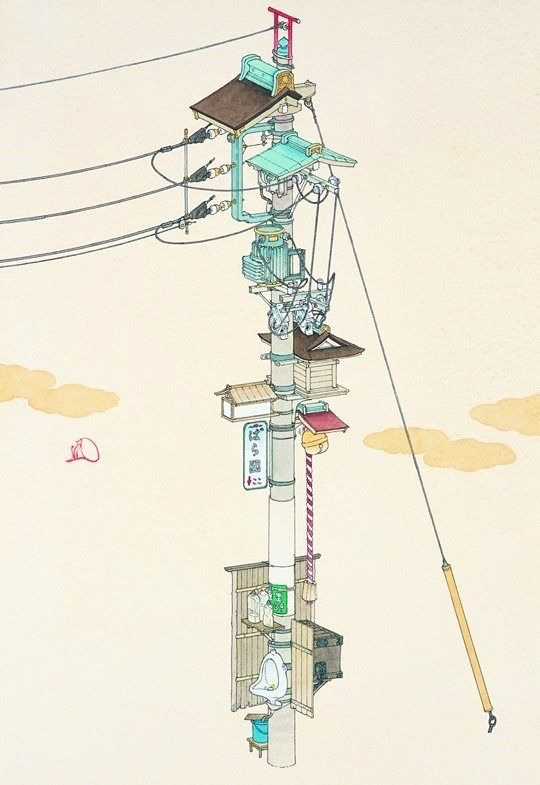
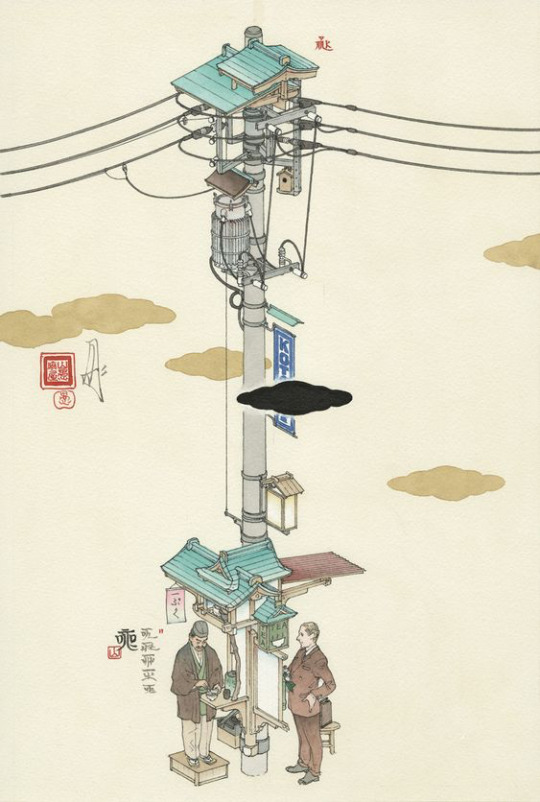
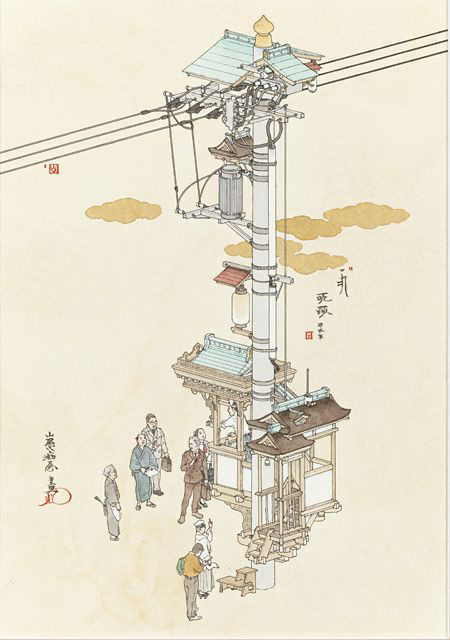
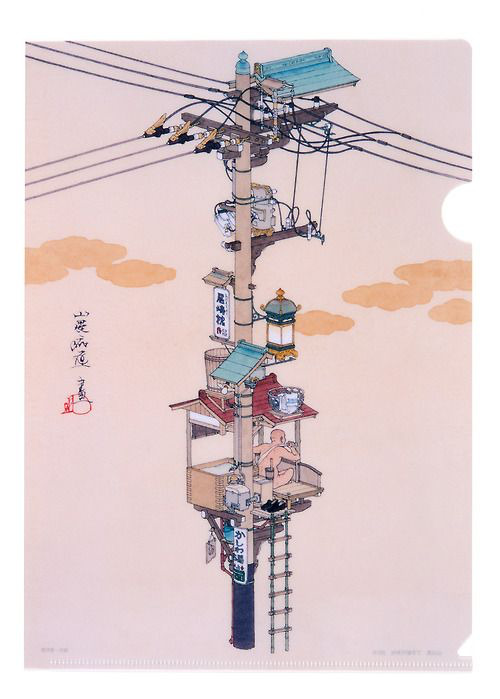
Electric poles can be seen as unrecognised backbones of communities, ensuring people are connected and in the know, also making way for trade, advertisement, etc. Yamaguchi's detailed drawings disperse a calm atmosphere and a sense of retrospection. They create a feeling of nostalgia over these pieces of infrastructure.
Not only that, but they do not portray infrastructure as a heavy, burdening mass of wires and lines suffocatingly entangled with one another, leaning down on poles that go up piercing the sky against the otherwise soft landscape, that weigh down the passers-by walking underneath; rather, they are portrayed as delicate structures hosting and hoisting Yamaguchi's interventions that visibly benefit the community and add practical amenities used in daily life.
This visceral observation changed the way I perceive electric poles and stirred up my curiosity to look into them more, while thinking about my voids.
7 notes
·
View notes
Text
Voids Given Use
Another precedent in the design field that deals with matters of pockets urban space is Atelier Bow Wow's Pet Architecture. They took left-over spaces around Tokyo such as narrow alleyways between buildings or parking lots, and injected new life into them, turning them into commercial venues or practical businesses.

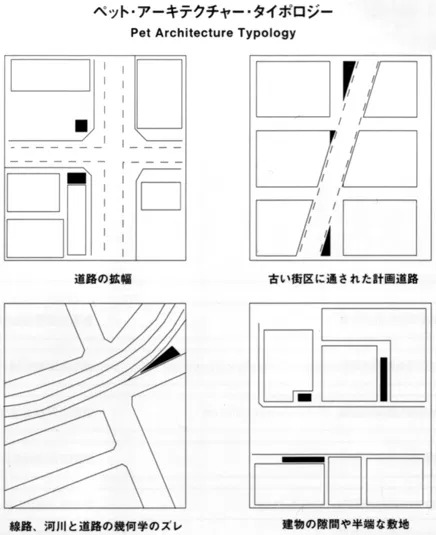

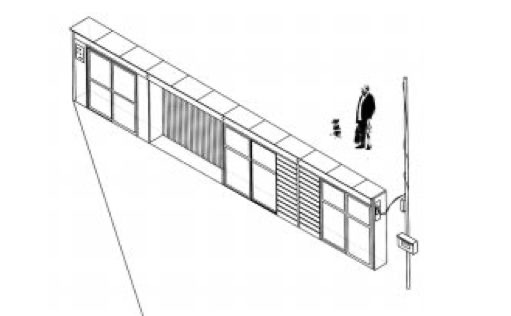

This also drove my focus to think of a slightly more practical or rather useful meaning for my series of sites that revolve around re-establishing communication, or lack thereof.
Images courtesy of Agile City and Pinterest.
1 note
·
View note
Text
Points and Ideas
Here are some ideas and bullet points I've been thinking about:
Work with BLANKS / VOIDS
Working with what is missing is more interesting; where something is missing, there is where you start to speculate
my site: vacant; abandoned voids in the city
slots between the architecture - encapsulate to create interior space
food manifesto: manifested in the city
Using food as a tool to infuse my manifesto into the city (using the specific sites)
specific sites: which ones qualify to be my blanks, and which ones don’t?
my manifesto needs to establish a concrete formula for selecting sites
each void has a different purpose
each proposal is informed by the users
identify the users…
who are the people who are looking for a specific blank space? and why?
think about click&collect and how to upgrade the experience?
1 note
·
View note
Text
Path of Voids in the Urban Grain
Next, I started thinking about how to infuse these concepts into the physicality and urban grain of Canterbury. There must be a site or series of sites that are already abandoned since this is also the main requirement on the brief, along with their purpose being hospitality related.
The central theme for this is, as previously elaborated on, the missing in the conversation. Therefore, to put this into the spatial world, I would need a void space - an abandoned site. Or, better yet, a series of abandoned sites.
Gordon Matta-Clark himself had a project before where he selected empty sites around New York which arguably resulted of poor city planning. Design magazine Socks Studio writes:
Starting in the summer of 1973, artist Gordon Matta-Clark purchased fifteen lots in the city of New York, fourteen in Queens and one in Staten Island. The specificity of these plots is to be tiny residual areas, often inaccessible parcels of land escaped for some reasons to the rules of the grid and the interests of the real estates. These “unuseless” spaces, sometimes even narrower than a person’s shoulders, were publicly auctioned by the city of New York for a price ranging between $25 and $75 each. Matta Clark’s collection of untenable properties included a triangular plot, a tiny strip of land between two houses, a curbsite. It was a catalogue of bits of land probably resulting from surveying errors or zoning oddities.
While documenting the irrationalities of a city, he basically questioned the meaning and value of land property, using these anomalies in the map to reveal its contradictions.
“They were a group of fifteen micro-parcels of land in Queens, left-over properties from an architect’s drawing. One or two of the prize ones were a foot strip down somebody’s driveway and a foot of sidewalk. And the others were curbstone and gutter space. What I basically wanted to do was to designate spaces that wouldn’t be seen and certainly not occupied.”
As Rosalind Krauss and Yve-Alain Bois point out in their essay “Formless” (Zone Books – 1997, from page 226): (the spaces) “wouldn’t be seen”, not so much because they were inaccessible (although this was true in some case), but because they had no use value whatsoever and only a purely nominal exchange value: these are fake commodities, fake real estate properties” (the title of the work, perhaps the most conceptual piece Matta Clark ever did, is Reality Propenies: Fake Estates (1973), which puns on the fact that reality is an archaic term for real estate). The parcels did not interest Matta-Clark unless they had no economic value whatever”.
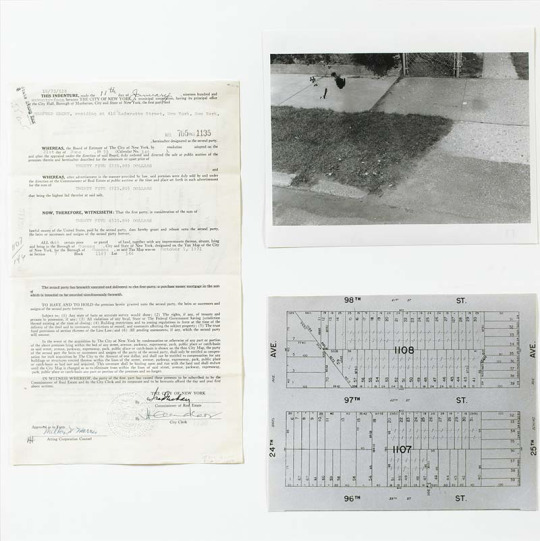


To start the same venture, I could also study Canterbury's master plans and search for irregularities and unused pockets of space. Or, I could walk through Canterbury and tangibly find and understand such occurrences in the urban grain and select a key few to take part in this manifesto.
Images courtesy of Socks Studio.
4 notes
·
View notes
Text
The Outcome of the Casting
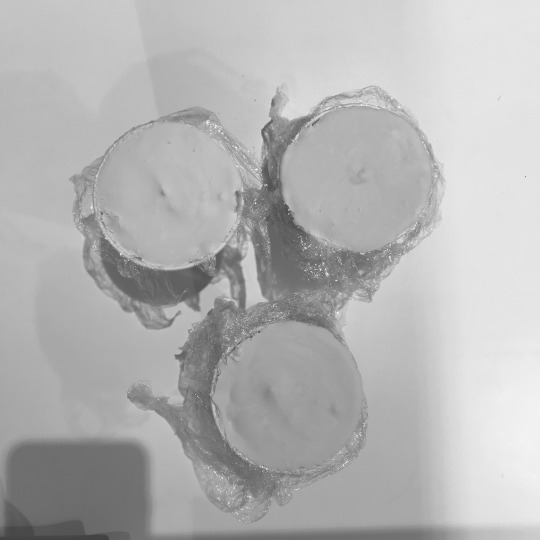
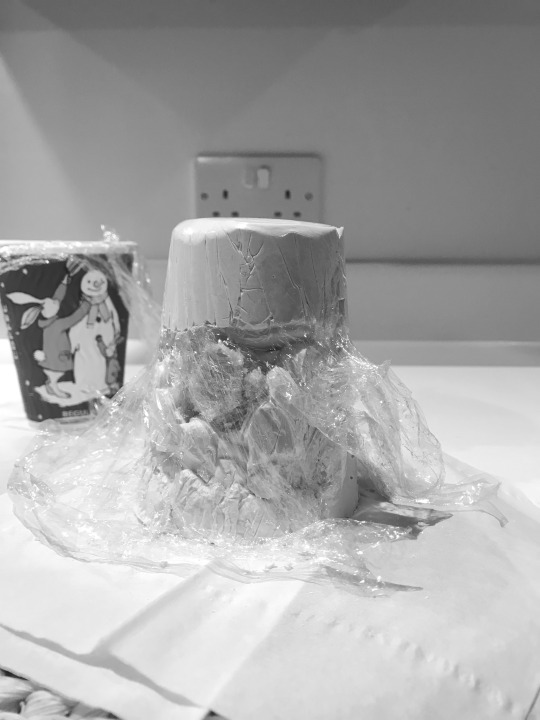


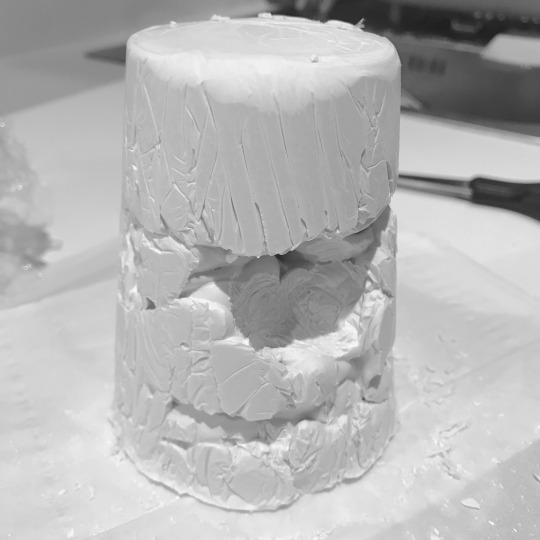
0 notes
Text
Casting voids attempt
After the research, I set on to create a manifesto piece. It would be a series of negative casts of something.
The first object that came to mind was bread, quite funnily, since the previous phase of the project revolved around that. I thought about bread as the core which is removed, similarly to how blanks in the conversation are left missing.

the assembly
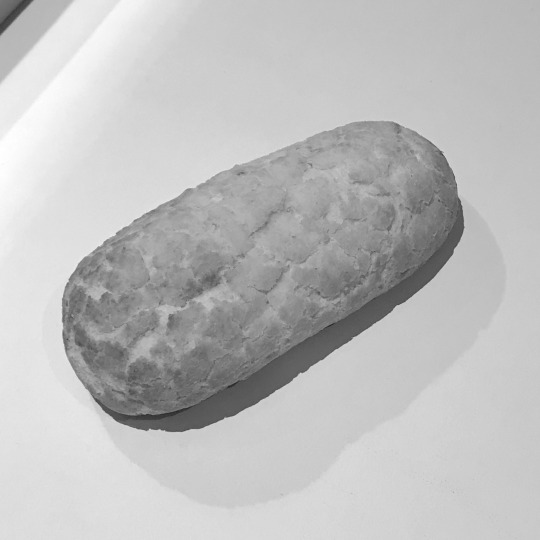
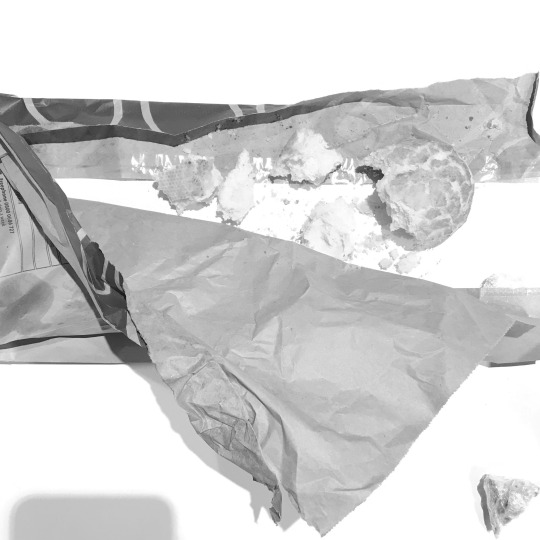
the component



the fill
Now it's time to wait for the result once it's dry...
0 notes
Text
More Voids in Space
After reading more on Gordon Matta-Clark's work, I was also directed to Rachel Whiteread who makes inverse casts of things - from every day objects or mementos, to large scale masses, such as chairs, fireplaces, or even full-blown houses.
I found this fascinating as well, since her work still records the object, not through the object itself but through its emptiness inside it, or the volume it occupies in its imminent surroundings.
youtube

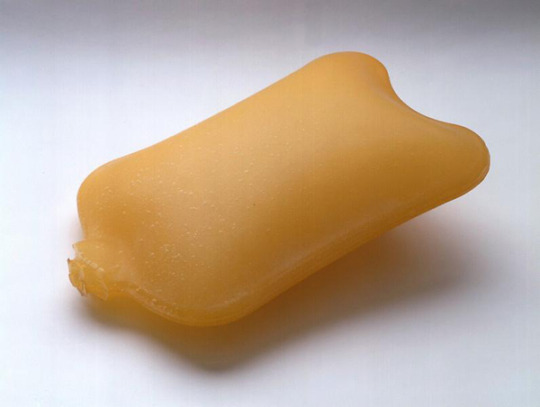

images courtesy of Treadland
0 notes